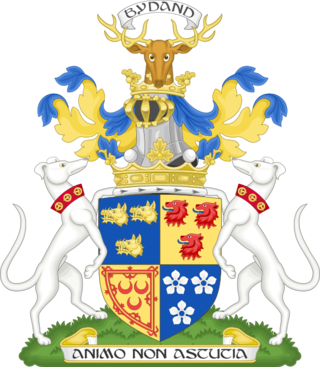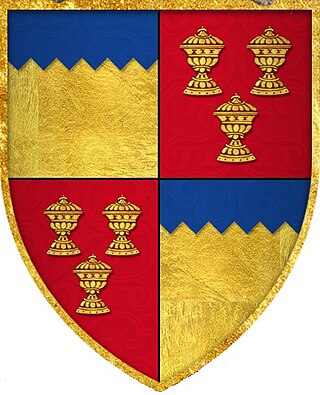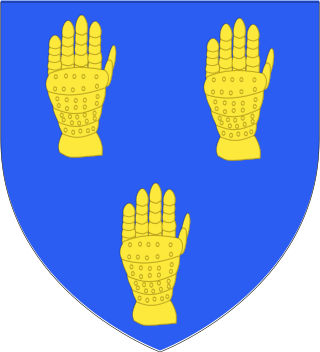Related Research Articles

Earl of Derby is a title in the Peerage of England. The title was first adopted by Robert de Ferrers, 1st Earl of Derby, under a creation of 1139. It continued with the Ferrers family until the 6th Earl forfeited his property toward the end of the reign of Henry III and died in 1279. Most of the Ferrers property and the Derby title were then held by the family of Henry III. The title merged in the Crown upon Henry IV's accession to the throne in 1399.

Earl of Longford is a title that has been created twice in the Peerage of Ireland.

Earl of Selkirk is a title in the Peerage of Scotland, used since 1646. It has rules of inheritance subject to unusual and unique provisions.

Marquess of Huntly is a title in the Peerage of Scotland that was created on 17 April 1599 for George Gordon, 6th Earl of Huntly. It is the oldest existing marquessate in Scotland, and the second-oldest in the British Isles; only the English marquessate of Winchester is older. The Marquess holds the following subsidiary titles: Lord Gordon of Strathaven and Glenlivet and Earl of Aboyne, and Baron Meldrum, of Morven in the County of Aberdeen.
There are currently two earldoms of Mar in the Peerage of Scotland, and the title has been created seven times. The first creation of the earldom is currently held by Margaret of Mar, 31st Countess of Mar, who is also clan chief of Clan Mar. The seventh creation is currently held by James Erskine, 14th Earl of Mar and 16th Earl of Kellie, who is also clan chief of Clan Erskine.

Earl of Rothes is a title in the Peerage of Scotland. It was created in 1458 for George Leslie, 1st Lord Leslie. He had already been created Lord Leslie in 1445, also in the Peerage of Scotland. His grandson, the third Earl, having only succeeded his elder brother in March 1513, was killed at the Battle of Flodden on 9 September of the same year. His son, the fourth Earl, served as an Extraordinary Lord of Session. Lord Rothes was also tried for the murder of Cardinal Beaton but was acquitted.

The title Earl of Kellie or Kelly is a title in the Peerage of Scotland, created in 1619 for Sir Thomas Erskine, who was Captain of the Guard and Groom of the Stool for James VI. It is named after Barony of Kellie in Fife, Scotland. Since 1875, it has been held jointly with the Earldom of Mar.

Earl of Northesk is a title in the Peerage of Scotland. It was created in 1662 for John Carnegie, who notably served as Sheriff of Forfarshire. He was given the subsidiary title of Lord Rosehill and Eglismauldie at the same time. Carnegie had already been created Earl of Ethie and Lord Lour in 1647 but relinquished those titles in exchange for the 1662 creations. For the purposes of precedence and seniority, the earldom of Northesk is treated as having been created in 1647, the date of the creation of the earldom of Ethie.

Earl of Dunmore is a title in the Peerage of Scotland.

Earl of Seafield is a title in the Peerage of Scotland. It was created in 1701 for James Ogilvy, who in 1711 succeeded his father as 4th Earl of Findlater. The earldoms of Findlater and Seafield continued to be united until 1811, when the earldom of Findlater became dormant, while the earldom of Seafield remains extant.

Earl of Gosford is a title in the Peerage of Ireland. It was created in 1806 for Arthur Acheson, 2nd Viscount Gosford.

Lord Kinloss is a title in the Peerage of Scotland. It was created in 1602 for Edward Bruce, later Master of the Rolls, with remainder to his heirs and assigns whatsoever. In 1604 he was also made Lord Bruce of Kinloss, with remainder to his heirs male, and in 1608 Lord Bruce of Kinloss, with remainder to any of his heirs. He was succeeded by his son, the second Lord, who was killed in a duel in 1613.

Earl of Kingston is a title in the Peerage of Ireland. It was created in 1768 for Edward King, 1st Viscount Kingston. The Earl holds the subsidiary titles Baron Kingston, of Rockingham in the County of Roscommon, Viscount Kingston, of Kingsborough in the County of Sligo, Baron Erris, of Boyle in the County of Roscommon, and Viscount Lorton, of Boyle in the County of Roscommon, also in the Peerage of Ireland. He is also a baronet in the Baronetage of Ireland. Between 1821 and 1869 the earls also held the title Baron Kingston, of Mitchelstown in the County of Cork, in the Peerage of the United Kingdom.

Earl of Rosslyn is a title in the Peerage of the United Kingdom. It was created in 1801 for Alexander Wedderburn, 1st Baron Loughborough, Lord Chancellor from 1793 to 1801, with special remainder to his nephew Sir James St Clair-Erskine, as Wedderburn had no surviving issue of his own. Wedderburn had already been created Baron Loughborough, of Loughborough in the County of Leicester, in the Peerage of Great Britain in 1780, with normal remainder to the heirs male of his body, and Baron Loughborough, of Loughborough in the County of Surrey, in the Peerage of Great Britain in 1795, with the same remainder as the earldom. The 1780 barony became extinct upon his death, but the 1795 barony and the earldom passed, by the special remainder, to his nephew, who thus became the second Earl of Rosslyn. The second Earl was a Lieutenant-General in the Army and also held political office as Lord Privy Seal and Lord President of the Council.
Margaret Alison of Mar, 31st Countess of Mar, is a Scottish hereditary peer and politician. She was a crossbench member of the House of Lords from 1975 to 2020 and was one of 92 hereditary peers elected to remain in the Lords in 1999. She is the holder of the original earldom of Mar, the oldest peerage title in the United Kingdom. She is the only suo jure countess and was the only female hereditary peer in the House of Lords from 2014 to 2020. She is also a farmer and former specialist goats cheesemaker in Great Witley, Worcestershire.

Piers Butler, 8th Earl of Ormond, 1st Earl of Ossory also known as Red Piers, was from the Polestown branch of the Butler family of Ireland. In the succession crisis at the death of Thomas Butler, 7th Earl of Ormond he succeeded to the earldom as heir male, but lost the title in 1528 to Thomas Boleyn. He regained it after Boleyn's death in 1538.

David Anthony Thomas Fane, 15th Earl of Westmorland,, styled Lord Burghersh until 1948, was a British courtier, landowner and member of the House of Lords.

Charles Stanley, 8th Earl of Derby was an English nobleman and politician. He was the eldest son of James Stanley, 7th Earl of Derby and Charlotte de La Trémouille.

Colonel George Charles Bingham, 5th Earl of Lucan, 1st Baron Bingham,, known by the courtesy title of Lord Bingham from 1888 to 1914, was a British soldier and Conservative politician.His sister Rosalind Hamilton, Duchess of Abercorn, was a paternal great-grandmother of Diana, Princess of Wales.

Earl of Arran is a title in the Peerage of Ireland. It is not to be confused with the title Earl of Arran in the Peerage of Scotland. The two titles refer to different places: the Aran Islands in Ireland, and the Isle of Arran in Scotland. The Irish earldom is held by the Gore family. The Scottish earldom is a separate title, held as a subsidiary title of the Duke of Hamilton.
References
- ↑ Butler, D. & Butler, G. (1994) British Political Facts 1900−1994. 7th edn. Basingstoke and London: The Macmillan Press, p. 35.
